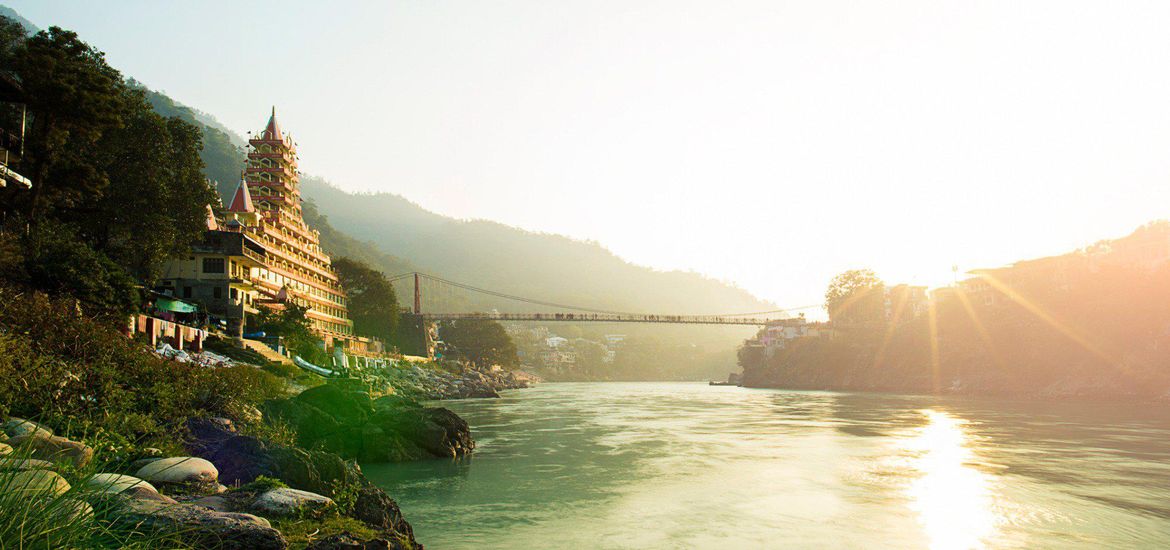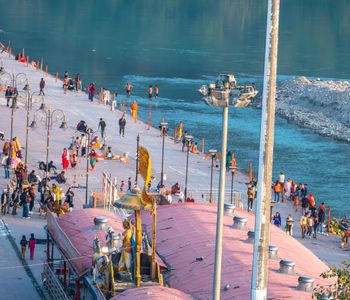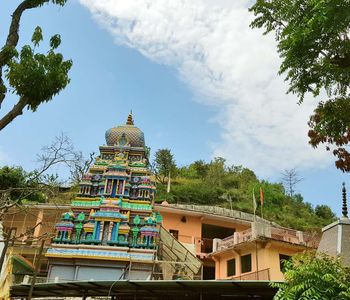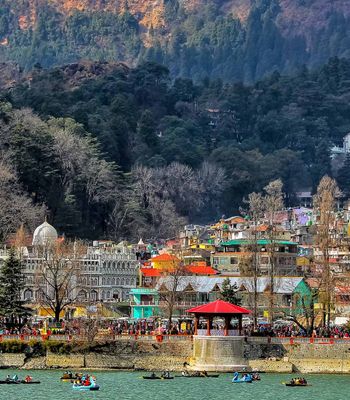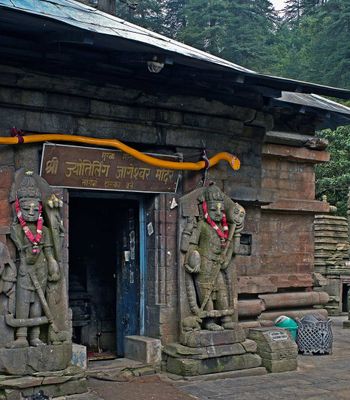Rishikesh, where spirituality and adventure meet, Lakshman Jhula stands as more than just a bridge; it is a journey through history. Hanging over the sacred Ganges, it carries stories of colonial craftsmanship and countless footsteps seeking peace.
Lakshman Jhula, connecting the Tapovan area in Tehri Garhwal with Jonk in Pauri Garhwal, stands out for its mythological significance. Whether you're chasing adventure or some quiet, every step across this iconic suspension bridge in Rishikesh feels like walking through time, with the mighty Himalayas watching over.
A Timeless Bridge Between Myth and History
Lakshman Jhula is a landmark of religious and historical significance. It is believed to be the site where Lord Lakshmana, the younger brother of Lord Rama, once crossed the River Ganges using just two jute ropes.
A 284-foot-long hanging rope bridge was constructed to honour this legendary event, which remained in use until 1889. This bridge was vital in connecting the regions on either side of the river, facilitating pilgrimage and daily travel.
In October 1924, a massive flood washed away the original rope bridge, making constructing a more substantial replacement necessary. The Public Works Department (PWD) of the United Provinces undertook the reconstruction, and between 1927 and 1929, an iron suspension bridge was built along the same route.
On 11 April 1930, Sir Malcolm Haley, then Governor of the United Provinces, officially inaugurated the 6-foot-wide bridge, which remained an essential pedestrian and motorbike crossing for decades.
However, in 2020, structural concerns led to its permanent closure, marking the end of its historic journey.
A Blend of Tradition and Engineering Excellence
Lakshman Jhula is not just a bridge but an architectural masterpiece, showcasing a blend of traditional craftsmanship and modern engineering. Designed as a suspension bridge, it exemplifies the ingenuity of early 20th-century construction techniques while seamlessly blending with Rishikesh's spiritual and natural beauty.
One of the most remarkable aspects of Lakshman Jhula is its 450-foot-long span, supported by steel suspension cables anchored on either side of the river. This design allows the bridge to withstand strong river currents and the high foot traffic of pilgrims and tourists. At 70 feet above the Ganges, the bridge offers a crossing, allowing visitors to witness the sacred river flowing beneath and the Himalayan foothills framing the horizon.
A Gateway to Spiritual and Scenic Wonders
Apart from its mythological significance and engineering marvel, the area surrounding Lakshman Jhula offers a range of captivating attractions. Here’s a closer look:
- Lakshman Temple: Located near the bridge's western end, this temple is dedicated to Lord Lakshmana, who is believed to have crossed the Ganges at this spot. The temple houses an ancient idol of Lakshmana and attracts devotees seeking blessings.
- Ram Jhula: A larger and more modern counterpart of Lakshman Jhula, Ram Jhula connects Swarg Ashram with Sivananda Ashram. The bridge offers stunning river views and is lined with buzzing marketplaces and sacred ghats.
- Triveni Ghat: A short distance from the bridge, Triveni Ghat is one of Rishikesh’s holiest sites, where the Ganga Aarti takes place every evening. The rhythmic chanting, flickering oil lamps, and the melodious sound of temple bells create an unforgettable spiritual experience.
- Beatles Ashram: A hidden gem, the Beatles Ashram (also known as Chaurasi Kutia) gained fame when the legendary rock band The Beatles visited in 1968. Now adorned with artistic murals and graffiti, the ashram uniquely blends music, history, and meditation.
- Parmarth Niketan Ashram: One of Rishikesh’s most prominent ashrams, Parmarth Niketan provides an immersive spiritual experience with yoga sessions, meditation retreats, and religious ceremonies. The ashram also hosts a grand Ganga Aarti, a must-attend event for visitors.
Lesser-Known Facts About Lakshman Jhula
Here are some lesser-known facts about Lakshman Jhula:
- Known initially as Jhula Pul (Swing Bridge), Lakshman Jhula got its name because it used to sway with the wind.
- Designed for durability, the bridge can bear loads of up to 50 tons.
- A favourite among celebrities, Lakshman Jhula has welcomed Bollywood icons like Amitabh Bachchan, Shah Rukh Khan, Aamir Khan, Salman Khan, Akshay Kumar, Priyanka Chopra, and Deepika Padukone for film shoots and sightseeing.
When to Cross Lakshman Jhula for the Most Magical Experience
The best time to visit Lakshman Jhula is from October to March, when the air is crisp, the skies are clear, and the temperatures hover between a comfortable 10°C and 25°C, setting the perfect stage for exploration. On the other hand, June to September is best avoided—monsoon rains lead to swollen rivers and slippery bridges, bringing unexpected travel disruptions.
For the most magical moments, set your alarm for sunrise (5:30 AM – 7:30 AM) when the world is still wrapped in a dreamy mist, or catch the sunset (5:00 PM – 7:00 PM) as the golden light paints everything in warm hues, leading into the soulful rhythms of the Ganga Aarti.
On the Way to the Iconic Lakshman Jhula
Situated in the spiritual heart of Rishikesh, Lakshman Jhula is easily accessible by air, rail, and road. Here’s how you can reach this iconic landmark with ease:
By Air
The nearest airport to Lakshman Jhula is Dehradun's Jolly Grant Airport (DED), approximately 22.7 km away. It offers direct flights from Delhi and other major cities. From there, you can hire a taxi or take a bus to Rishikesh, which takes about 40 - 45 minutes.
By Train
The closest railway station to Lakshman Jhula is Rishikesh Railway Station, about 8 km away. It has excellent connectivity with major cities like Delhi, Mumbai, and Kolkata. From there, you can reach your destination by taxi, bus, or shared auto-rickshaw in around 25 minutes.
By Road
Rishikesh is well-connected by road, with frequent buses from Delhi and nearby cities. Once you arrive at the Rishikesh Bus Stand, Lakshman Jhula is approximately 5.5 km away and can be reached via local transport options such as tuk-tuks or taxis in only 20 minutes.
Lakshman Jhula is an experience that lingers long after you’ve crossed it. Whether it’s the whisper of mythology in the wind, the thrill of walking above the sacred Ganges, or the golden glow of the Himalayas at dusk, this place leaves a mark on your soul. And even though the bridge itself may have closed, its legacy remains etched in stories and prayers.
